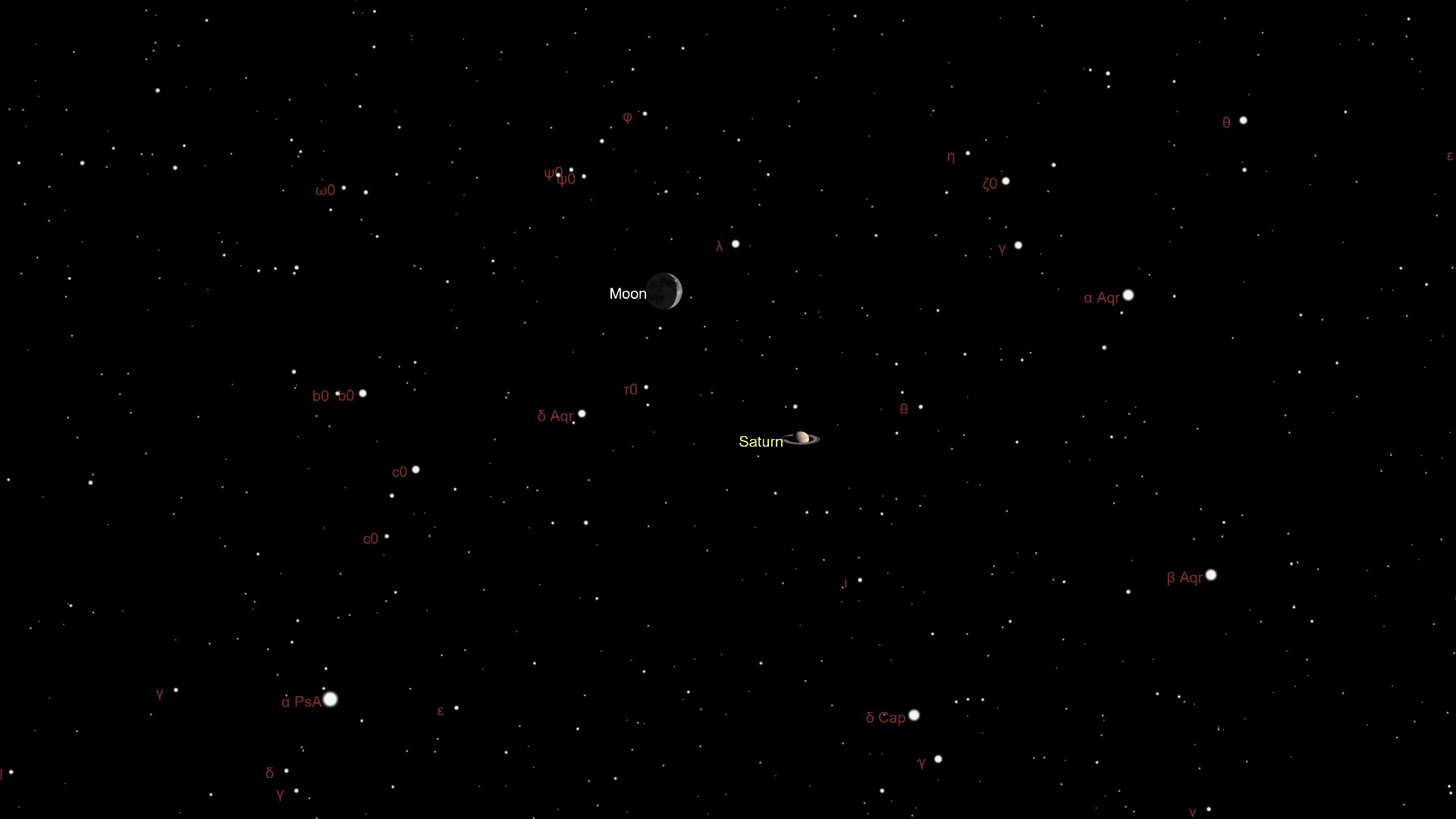See a thin crescent moon meet up with Saturn tonight
The nearly new moon is set for a close approach to the ringed gas giant.

The thin crescent moon will meet up with the solar system's second-largest planet, Saturn for the first time in 2024 on Sunday (Jan. 14), during a close approach between the two celestial bodies.
At the same time, the 3-day-old moon will move into an astronomical arrangement with Saturn, the sixth planet from the sun, called a conjunction — which refers to the fact that the two bodies will have the same right ascension, or celestial equivalent of longitude.
During the close approach, the moon, which is just leaving its totally darkened new moon phase, will get as close to Saturn as 1.5 degrees. At the exact moment of conjunction, the moon will be 2 degrees to the south of Saturn. Both bodies will be in the constellation Aquarius at the time of conjunction.
Related: Night sky, January 2024: What you can see tonight

Looking for a telescope to see the planets of the solar system up close? We recommend the Celestron Astro Fi 102 as the top pick in our best beginner's telescope guide.
From New York City, skywatchers will be able to see the meet-up between the sliver of the nearly new moon, which will be just 16% illuminated, and Saturn shortly after the two celestial objects rise to 25 degrees over the horizon to the southwest at around 5:30 p.m. EST (2230 GMT), according to In the Sky. The moon and Saturn will be visible until around 8:10 p.m. EST (0110 GMT) when the pair, which is around 3 hours and 20 minutes after the sun sets around 4:50 p.m. EST (2150 GMT).
Though this is a close approach, the moon and Saturn will still be too widely separated to be visible together in the field of view of a telescope, though they will appear side-by-side in the wider field of view of binoculars.
The moon will dominate Saturn in terms of size and brightness, with a magnitude of -10.5 (with the minus prefix indicating a bright object over Earth); Saturn will shine at magnitude of 0.8 and will be over 100 times smaller than the moon in terms of apparent size.
Breaking space news, the latest updates on rocket launches, skywatching events and more!
The moon's domination of Saturn in the sky on Thursday is merely an effect of its proximity to Earth in comparison to the second-largest planet in the solar system. On average, the moon is around 238,855 miles (384,400 km) away from Earth, while Saturn is 746 million miles (1.2 billion km) from our planet at its very closest. That means the system of Earth and the moon at their average separation would fit in the distance between Earth and Saturn over 3,123 times, even when the two planets are at their absolutely closest proximity.
The situation is dramatically reversed in the actual solar system. The moon is around 2,159 miles (3,475 kilometers) wide, about a quarter of the size of Earth, while Saturn has a diameter of 72,400 miles (116,500 km), making it nine times the size of our planet. To put this into perspective, NASA says that if Earth was a nickel, Saturn would be a basketball. Ultimately, this means it would take at least 36 moons to stretch across the width of Saturn.
The difference in size between the moon and Saturn becomes more striking when the volumes of the two bodies are factored in. The space Saturn occupies in the solar system would be filled by around 764 Earths, and it would take about 50 moons to fill the volume of our planet. That means it would take an incredible 38,200 moons to fill the volume of space occupied by the ringed gas giant.
If you are hoping to catch a close-up look at the moon or Saturn in the night sky and don't have the optics you need, our guides to the best telescopes and best binoculars are a great place to start.
And if you're looking to snap photos of the moon and Saturn, or just the night sky in general, check out our guide on how to photograph the moon or how to photograph the planets as well as our best cameras for astrophotography and best lenses for astrophotography.
Editor's Note: If you snap an image of the moon's conjunction with Saturn and would like to share it with Space.com’s readers, send your photo(s), comments, and your name and location to spacephotos@space.com.

Robert Lea is a science journalist in the U.K. whose articles have been published in Physics World, New Scientist, Astronomy Magazine, All About Space, Newsweek and ZME Science. He also writes about science communication for Elsevier and the European Journal of Physics. Rob holds a bachelor of science degree in physics and astronomy from the U.K.’s Open University. Follow him on Twitter @sciencef1rst.
